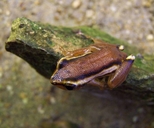|
Hyperolius mitchelli Loveridge, 1953
Mitchell's Reed Frog | family: Hyperoliidae genus: Hyperolius |
 © 2005 Michal Berec (1 of 32) |
|
|
|
Description Phase J has a brownish dorsum with diffuse darker spots, Ventral surfaces yellow to orange. Phase F: Dorsum darker or lighter brown with diffuse darker spots. A broad, black-edged silverish canthal and dorsolateral line is always present from tip of snout almost to groin. A spot of the same colour is present on the heel. Ventrum yellow to orange. The relationship with the similar, sympatric H. puncticulatus is mentioned under that species. Distribution and Habitat Country distribution from AmphibiaWeb's database: Malawi, Mozambique, Tanzania, United Republic of
Life History, Abundance, Activity, and Special Behaviors Eggs are laid on leaves overhanging the water in clutches of 50-100. The tadpole has papillae on the rostrum and a complex of lingual papillae that form a dense filter at the front of the mouth (Channing et. al. 1987). Comments This account was taken from "Treefrogs of Africa" by Arne Schiøtz with kind permission from Edition Chimaira publishers, Frankfurt am Main.
References
Schiøtz, A. (1999). Treefrogs of Africa. Edition Chimaira, Frankfurt am Main. Originally submitted by: Arne Schiøtz (first posted 2001-01-29) Edited by: Kellie Whittaker (2008-09-10) Species Account Citation: AmphibiaWeb 2008 Hyperolius mitchelli: Mitchell's Reed Frog <https://amphibiaweb.org/species/552> University of California, Berkeley, CA, USA. Accessed Jan 3, 2025.
Feedback or comments about this page.
Citation: AmphibiaWeb. 2025. <https://amphibiaweb.org> University of California, Berkeley, CA, USA. Accessed 3 Jan 2025. AmphibiaWeb's policy on data use. |



 Map of Life
Map of Life